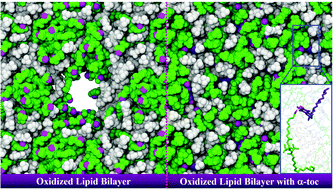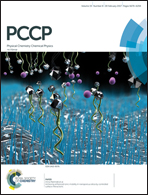Alpha-tocopherol inhibits pore formation in oxidized bilayers†
Abstract
In biological membranes, alpha-tocopherols (α-toc; vitamin E) protect polyunsaturated lipids from free radicals. Although the interactions of α-toc with non-oxidized lipid bilayers have been studied, their effects on oxidized bilayers remain unknown. In this study, atomistic molecular dynamics (MD) simulations of oxidized lipid bilayers were performed with varying concentrations of α-toc. Bilayers with 1-palmitoyl-2-lauroyl-sn-glycero-3-phosphocholine (PLPC) lipids and their aldehyde derivatives at a 1 : 1 ratio were studied. Our simulations show that oxidized lipids self-assemble into aggregates with a water pore rapidly developing across the bilayer. The free energy of transporting an α-toc molecule in a bilayer suggests that α-tocs can passively adsorb into it. When α-toc molecules were present at low concentrations in bilayers containing oxidized lipids, water pore formation was slowed down. At high α-toc concentrations, no pores were observed. Based on the simulations, we propose that the mechanism of how α-toc inhibits pore formation in bilayers with oxidized lipids is the following: α-tocs trap the polar groups of the oxidized lipids at the membrane–water interface resulting in a decreased probability of the oxidized lipids making contact with the two leaflets and initiating pore formation. This demonstrates that α-toc molecules not only protect the bilayer from oxidation but also help to stabilize the bilayer after lipid peroxidation occurs. These results will help in designing more efficient molecules to protect membranes from oxidative stress.

- This article is part of the themed collection: 2017 PCCP HOT Articles


 Please wait while we load your content...
Please wait while we load your content...